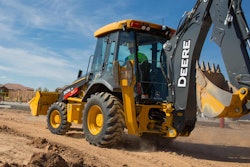
Technical colleges are keeping an eye on the changes in machine technology and what the future holds by working with their industry partners to help prepare their students.
“This is a high-tech industry and that is becoming more apparent every day,” says Craig Kuehl, instructor at Milwaukee Area Technical College.
The college’s diesel technician program relies on equipment manufacturers to help stay abreast of new machine technology.
“We have several OEMs that support our program by allowing us access to their online training and service information,” he says. “We try to support them in return by producing entry-level technicians for the dealer body as well as the fleets that service their vehicles.”
State University of New York at Cobleskill relies on similar partnerships. Doug Hammond, chairman of the Agricultural Engineering Technology Department, says John Deere has provided the college with assistance for teaching grade control and hybrid technology. Caterpillar and Trimble have provided the school with loaner equipment for learning about grade control. They also send representatives to talk to students about the future of the industry and potential career paths.
Harnessing the power of virtual reality
SUNY Cobbleskill recently won a $1.9 million grant from the U.S. Department of Labor to create a mobile training unit for student training and recruitment.
“We’re taking it on the road,” Hammond says.
The college plans to buy simulators for excavator and motor grader operation, as well as a welding simulator and training tools for electro-hydraulic equipment.
“It’s a tool that allows us to get the students that we have coming in that don’t have a lot of exposure to the equipment,” Hammond says of the equipment simulators. “They can get into that piece of equipment and operate it safely and start to realize they can do this, and they actually can see how a system functions. … They do that safely before we actually put them in the seat.”
A big part of the grant is outreach to the high schools, and bringing in the simulators, other technology and equipment will help not only attract students but inform teachers about the industry, he says. Dealers will also be involved and possibly bring in equipment, with the ultimate goal of matching future employers with future technicians.
“We’re trying to change the image of what the technician is seen as,” Hammond says. “…I think if they actually saw who we were and what we do and what the modern shop looks like today, they would be very impressed, and when I say ‘they,’ I mean the parents, the teachers and the students.”
The college has been aggressively reaching out to schools over the years, but he believes the new grant initiative will provide the needed boost to take recruitment to a higher level.
“We haven’t gone out to work with the teachers and brought them the tools that they need to help prepare the students to be with us … something that will help the students see the pathway toward being a technician and what the potential can be there,” he says.
“This isn’t just a mobile outreach,” he adds. “We’re trying to also develop the big pathway.”
Technology challenges and opportunities
The college faces challenges, though, when it comes to new technology. One of the main ones is finding the time to teach it.
“There’s only so much time that we have to work with the students,” Hammond says, “so adding anything into the curriculum is at the sacrifice of something.”
Another challenge is just keeping up with advancements and getting trained, so the instructors can pass that knowledge on to students.
Hammond agrees the industry is getting more technical and sees that new technology possibly opening the door to less traditional students becoming interested in the technician field.
“Because of the amount of computer technology, because of the use of the cloud and web-based stuff, I think you’re going to find people that may not be the typical technician but might be more oriented toward computer technology. They’re going to find niches within this industry,” he says. “And I think we need to get those people involved and give them an overview of how the equipment works so that they can be familiar and work with it. I see it as allowing us to branch out into new opportunities for recruitment.”
For more on the diesel technician shortage and how it’s affecting the construction industry, as well as what can be done to address it, check out Equipment World‘s series by clicking here.















